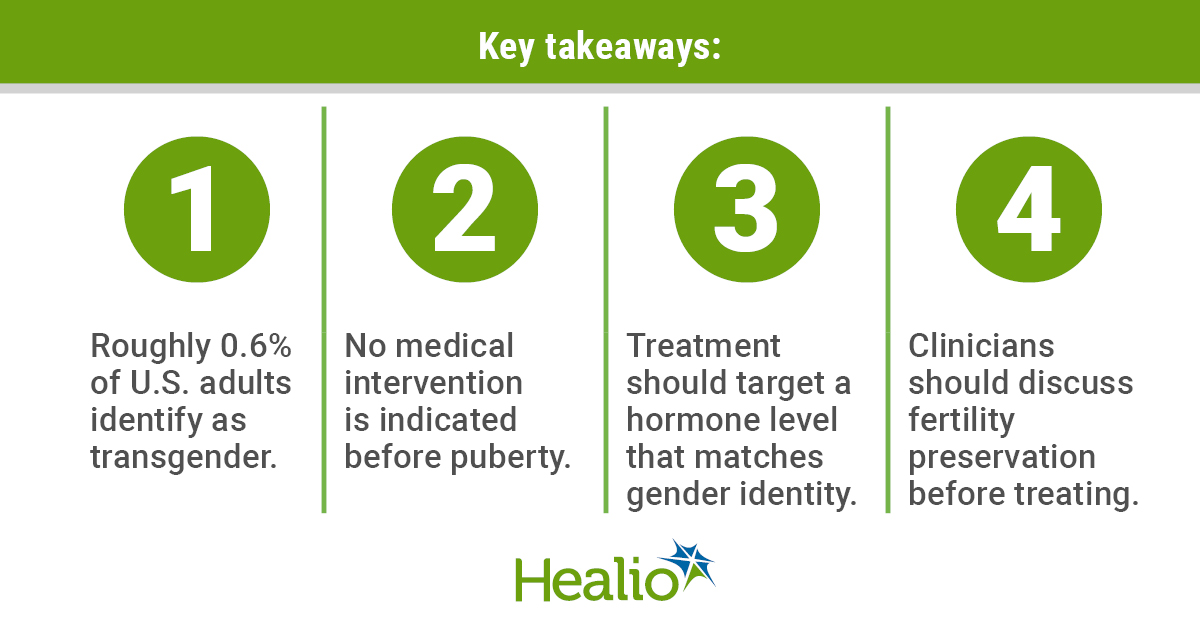Care for transgender persons: What clinicians should know

Proper care for transgender individuals begins with provider education and recognition that gender incongruence is not primarily a mental health condition, according to a clinical practice update published in The New England Journal of Medicine.
Data from the 2016 Behavioral Risk Factor Surveillance System at the CDC suggest that approximately 0.6% of U.S. adults, or 1.4 million people, identify as transgender, according to Joshua D. Safer, MD, medical director of the Center for Transgender Surgery and Medicine at the Mount Sinai Health System, and Vin Tangpricha, MD, PhD, FACE, professor of medicine in the division of endocrinology, diabetes and lipids at Emory University School of Medicine, program director of the Emory Endocrinology Fellowship Program. Many transgender people experience barriers to health care access and medical mistreatment. In an online survey of more than 6,000 transgender and gender-nonbinary persons, approximately 25% of respondents reported that they had been denied medical services and 30% reported that they had avoided care owing to fear of discrimination, Safer and Tangpricha wrote.
“When it comes to access to health care for transgender individuals, the biggest barrier to care continues to be a lack of knowledgeable providers,” Safer, also an Endocrine Today Editorial Board Member, said in an interview. “There are many transgender people, and the only way access to care will improve is if more providers in mainstream medicine feel comfortable providing that care. Specifically, we are talking about primary care providers and pediatricians. This also means providers taking on the narrow elements of that care that are already inside the domain of their respective specialties.”

Safer and Tangpricha outlined key points for providers to consider when caring for transgender individuals.
Presentation, assessment
Children may label genders and articulate gender identity by age 2 years, the researchers wrote. In surveys, up to 2.7% of children may report gender incongruence, but many such children do not continue to do so later in life. No medical intervention is indicated before puberty. When puberty begins, reversible therapy with a gonadotropin-releasing hormone agonist can delay puberty until a long-term treatment plan can be established.
“Desire to avoid the ‘wrong puberty’ may be the catalyst for some adolescents to report their gender incongruence when they had not done so earlier,” Safer and Tangpricha wrote. “In retrospect, many transgender persons report that their awareness of their gender incongruence began before puberty.”
Transgender identity is established on the basis of history alone; gender incongruence should be persistent, typically being present for years.
Any clinician evaluation of transgender patients should include an assessment of anxiety, depression and suicidality, all of which are reported to be more common among transgender than cisgender persons, the researchers wrote.

Providers of mental health care should participate in the assessment of adults if a mental health condition is suspected or identified and participate routinely in the assessment of children and adolescents, who may articulate gender identity more heterogeneously.
The researchers noted that not all transgender people seek medical intervention. In one online survey, just over half of transgender respondents reported having sought hormonal or surgical therapy.
Gender-affirming therapy
Criteria for the prescription of hormone therapy include persistent gender incongruence, the capacity to make informed treatment decisions, and reasonable control of associated mental health conditions. For transgender women, conventional therapeutic goals are to reduce facial hair growth, induce breast development and induce the redistribution of fat and muscle to a more feminine pattern. Treating clinicians should target a hormone level that matches gender identity, moving testosterone levels from the male range (300 ng/dL to 1,000 ng/dL) to the female range (< 50 ng/dL) and targeting estradiol levels in the range of 100 pg/mL to 200 pg/mL.
For transgender men, regimens include testosterone esters, gels and patches, with the goal of raising hormone levels to the male physiologic range (300 ng/dL to 1,000 ng/dL).
“After approximately 3 to 6 months of treatment, transgender men can anticipate cessation of menses, development of a deeper voice, and increases in facial and body hair, muscle mass, and sexual desire,” the researchers wrote. “Acne may develop or worsen transiently and should be treated if troublesome. Other changes may occur over longer periods, such as the development of a male hair pattern and clitoral enlargement.”
Clinicians should also discuss fertility preservation with transgender persons, as gender-affirming HT may reduce fertility and genital reconstruction surgery can destroy reproductive potential entirely.
“Before they start any treatment, patients should be encouraged to consider fertility preservation,” the researchers wrote. “Transgender women may consider cryopreservation of sperm and transgender men cryopreservation of oocytes or embryos. Preservation of embryos is a more established procedure, but the costs of cryopreservation of both oocytes and embryos are high.”
Management is more complicated with transgender children, who may be uncertain regarding their future interest in fertility and may not have developed gametes that are suitable for storage, the researchers noted.
‘Areas of uncertainty’
The long-term consequences of gender-affirming HT and the best strategy for surveillance remain unclear, the researchers wrote, adding that studies that compare the effects of different medical regimens and strategies for monitoring patients are lacking.
“For example, the measurement of estradiol alone in transgender women does not reflect levels of other estrogens that may be present (eg, estrone produced by the liver after oral ingestion of estradiol),” the researchers wrote. “Some persons choose lower hormone doses (eg, because they identify as nonbinary); it is unknown whether lower doses are associated with bone loss.”
Both the Endocrine Society and World Professional Association for Transgender Health provide guidelines for the medical care of transgender persons, and Safer and Tangpricha highlighted “areas of uncertainty” noted by the two organizations. The Endocrine Society’s revised guideline no longer mandates that providers of mental health determine gender identity for adults; however, the guideline still expresses preference for participation by such providers when making an assessment. The Endocrine Society guideline also recommends monitoring prolactin levels for transgender women and considering hysterectomy for transgender men as prophylaxis for cancer.
“We refer to new data that suggest these procedures may not be necessary,” the researchers wrote.
“This article continues the overall trajectory of making it clear that transgender care is the domain for primary care providers and for all medical providers, and not limiting this nor designating this as a mental health-specific concern above others,” Safer said. – by Regina Schaffer
For more information:
Joshua D. Safer, MD, can be reached at the Center for Transgender Medicine and Surgery, Room D-240, Center for Advanced Medicine, 17 E. 102nd St., New York, NY 10029; email: jsafer0115@gmail.com.
Disclosure: Safer reports he has served on an advisory panel for Endo Pharmaceuticals in 2018. Tangpricha reports no relevant financial disclosures.

